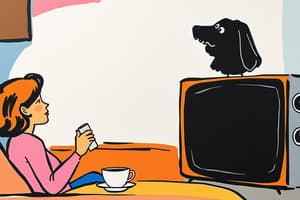Podcast
Questions and Answers
What is the typical duration of a sitcom episode?
What is the typical duration of a sitcom episode?
- 30-45 minutes
- 22-30 minutes (correct)
- 60 minutes
- 15-20 minutes
Which element is primarily established during Act One of a sitcom?
Which element is primarily established during Act One of a sitcom?
- Resolution of the main conflict
- Characters and the main conflict (correct)
- The climax of the episode
- Introduction of the tag scene
Which comedic technique involves humor arising from character traits and relationships?
Which comedic technique involves humor arising from character traits and relationships?
- Physical comedy
- Running gags
- Character-driven humor (correct)
- Situational irony
What is the purpose of a cold open in a sitcom?
What is the purpose of a cold open in a sitcom?
What typically occurs during Act Two of a sitcom episode?
What typically occurs during Act Two of a sitcom episode?
What is a common theme explored in sitcoms?
What is a common theme explored in sitcoms?
How do modern sitcoms differ from classic sitcoms?
How do modern sitcoms differ from classic sitcoms?
What is the primary function of the tag scene in a sitcom?
What is the primary function of the tag scene in a sitcom?
Flashcards are hidden until you start studying
Study Notes
Sitcom Structure
-
Definition: A sitcom (situational comedy) is a genre of comedy centered around a fixed set of characters in a consistent environment.
-
Typical Format:
- Duration: Usually 22-30 minutes per episode.
- Episodes: Often have self-contained storylines while contributing to overarching narratives.
-
Core Elements:
- Characters:
- Protagonist(s): Central characters, often relatable or eccentric.
- Supporting Cast: Friends, family, and background characters that contribute to comedic situations.
- Setting:
- Familiar and consistent (e.g., home, workplace, café).
- Allows for recurring themes and jokes.
- Characters:
-
Structure:
- Cold Open:
- Brief scene before the opening credits to hook the audience.
- Act One:
- Establishes characters and the main conflict or situation.
- Introduces humorous elements or misunderstandings.
- Act Two:
- Conflict escalates, often leading to various comedic situations.
- Secondary subplots may develop.
- Act Three:
- Climax and resolution, typically tying up storylines.
- Often includes a twist or unexpected resolution.
- Tag Scene:
- Short humorous scene post-credits that provides an additional punchline.
- Cold Open:
-
Comedy Techniques:
- Character-driven humor: Humor arises from character traits and relationships.
- Situational irony: Contrasting expectations and reality for comedic effect.
- Running gags: Recurring jokes or situations familiar to the audience.
-
Themes:
- Family dynamics, friendship, social issues, and cultural commentary.
- Often features relatable life struggles presented through a comedic lens.
-
Examples:
- Classic shows: "Friends," "Seinfeld," "The Office."
- Modern examples: "Brooklyn Nine-Nine," "Schitt's Creek."
-
Evolving Formats:
- Inclusion of serialized storytelling.
- Blending with other genres such as drama or fantasy.
-
Audience Engagement:
- Sitcoms often cultivate loyal viewership through relatable characters and ongoing story arcs.
- Consideration of audience feedback can shape future episodes or seasons.
Sitcom Definition and Format
- Sitcoms are a genre of comedy focusing on consistent characters in the same environment.
- Episodes typically last 22-30 minutes and have self-contained storylines while contributing to overarching narratives.
Sitcom Key Elements
- Characters:
- Protagonists are central characters with relatable or eccentric personalities.
- Supporting characters like friends, family, and background figures fuel comedic situations.
- Setting:
- A consistent, familiar setting (e.g., home, workplace, café) supports recurring themes and jokes.
- Structure:
- The cold open is a brief scene before opening credits to grab the audience's attention.
- Act one establishes characters, the main conflict, and introduces humor.
- Act two amplifies the conflict, leading to comedic events, and potentially introducing subplots.
- Act three features the climax, resolution, and often a twist or unexpected ending.
- A tag scene is a humorous post-credits scene that reinforces the punchline.
Sitcom Comedy Techniques
- Character-driven humor: Humor is derived from character traits and their interactions.
- Situational irony: Contrasting expectations with reality creates comedic effect.
- Running gags: Repeating jokes or situations provide familiarity for the audience.
Sitcom Themes
- Sitcoms often explore themes of family dynamics, friendship, social issues, and cultural commentary.
- They present relatable life experiences through a comedic lens.
Examples of Sitcoms
- Classic Sitcoms: "Friends," "Seinfeld," "The Office."
- Modern Sitcoms: "Brooklyn Nine-Nine," "Schitt's Creek."
Evolving Sitcom Formats
- Sitcoms are evolving to incorporate serialized storytelling, blending with other genres like drama or fantasy.
Audience Engagement
- Sitcoms often foster loyal viewership through relatable characters and ongoing storylines.
- Audience feedback can influence future episodes or seasons.
Studying That Suits You
Use AI to generate personalized quizzes and flashcards to suit your learning preferences.




